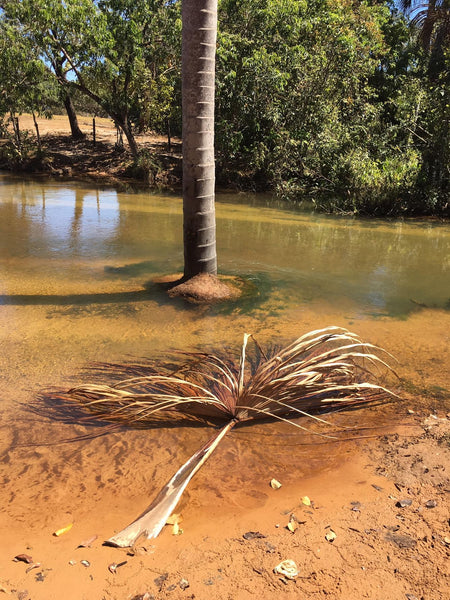- Continue Shopping
- Your Cart is Empty
Nature. Undedited.
Traditionally, when you're creating an aquarium, doesn't it seem like you find yourself adding a little of this or a bit of that until you get the right "look?" You spend a lot of time positioning this piece of wood, or bit of rock, or whatever, to get it just right.

And it's a process that involves pleasing our aesthetic "palette", so to speak. And that is an important part of the creative process.
We "edit."
Equally important, when we are talking about creating natural-looking and functioning aquariums, is to make that "mental leap" and remind ourselves constantly that Nature is simply not really a spotless, geometrically organized place.

I'm not implying that Nature is "dirty" in the sense that it's polluted...although sadly, in some parts of the world, it most definitely is. Rather, in the context of this piece, we're referring to the term "dirty" as an aesthetic descriptor of the earthy, brown, seemingly disorganized place that Nature actually is.

Even though it sounds rather harsh, I cringe when I see the words "Natural" or "Nature" used to describe an aquarium that is a spotless, "diorama-esque" art piece, with bears as much resemblance of the natural habitats of our fishes as a potted plant does to a tropical jungle.

We need to be comfortable simply calling them what they are: Aquascaped aquariums. There is absolutely nothing wrong with that term. These aquariums are often breathtaking; executed with style and grace by talented hobbyists worldwide. They incorporate some natural materials, like plants, rocks, and wood- yet they are presented in such a way as to essentially "cleanse" most of what some would see as "aesthetically unacceptable" parts of Nature.

If there's one thing that I'd like our work here at Tannin Aquatics to elevate, it's the unfiltered beauty of Nature. An appreciation for the way Nature is- not the way our preconceived aesthetic notions want it to be.
Nature, unedited.
And that is something that we understand is not appealing to everyone. And sort of "sticking it in everyone's face" and suggesting that a truly "natural" aquarium requires the acceptance of a very polarizing aesthetic certainly can turn off some people.
I do get it.
However, I see little downside to studying Nature as it is.

It's very important, IMHO, to at least have a cursory understanding of how these habitats have come to be; what function they perform for the piscine inhabitants who reside there, and why they look the way they do. Even if you simply despise the types of aquariums we love here!

Why?
Because in the process of learning about Nature as it is, and the uniqueness and fragility of the habitats we love, we become more attuned to the way aquatic ecosystems function, and the threats these wild systems face. And when we have a greater understanding of the habitats themselves, we have a greater understanding of how to replicate their form and function in the aquarium.

Simply copying exactly every beautiful aquarium you see here, or elsewhere online deprives us of the amazing opportunity to study and be inspired by the wonders of Nature as it is.
Nature. Unedited.
A confluence of terrestrial and aquatic elements, working together to create a unique and inspiring habitat. By selecting to replicate, at least on some level, an "unedited" interpretation of these habitats, we open up new aesthetic possibilities, foster breakthroughs in aquatic husbandry, and further the state of the art of the aquarium hobby.

Stay curious. Stay observant. Stay excited. Stay inspired...
And Stay Wet.
Scott Fellman
Tannin Aquatics
(Amazing pics for this piece were furnished by Thomas Minessi, Tai Strietman, Cory Hopkins, and Johnny Ciotti)
2 Responses
Scott Fellman
Greta observations and thoughts. I agree that Nature does a surprisingly large amount of the “heavy lifting” in our aquariums, both aesthetically and functionally, if allowed to do so, I’d love to see more aquarists accept the wonder and beauty of these processes, rather than trying to “circumvent” them in an effort to “one up” Nature for some undefined benefits.
-Scott
Peter
I live in Scotland, if you take a walk into the Highlands and come across a stream you will often see sitting on top of the brown water in quiet eddies dirty white foam. It is easy to think this is pollution, but it isn’t. These streams drain peat bogs, which is they water is brown and the peat contains proteins and long chain acids etc and the steeper, more wild water parts whip those components into foam. It too is transient, as those streams connect to bigger rivers or lochs the foam is dissolved into the mass. You need the right sized stream with rocky banks providing sufficient eddies to see it.
I’m not proposing we should sculpt foams to sit on our tank surfaces only to point out that Nature provides a wide variety of perfectly natural things.






Scott Fellman
Author